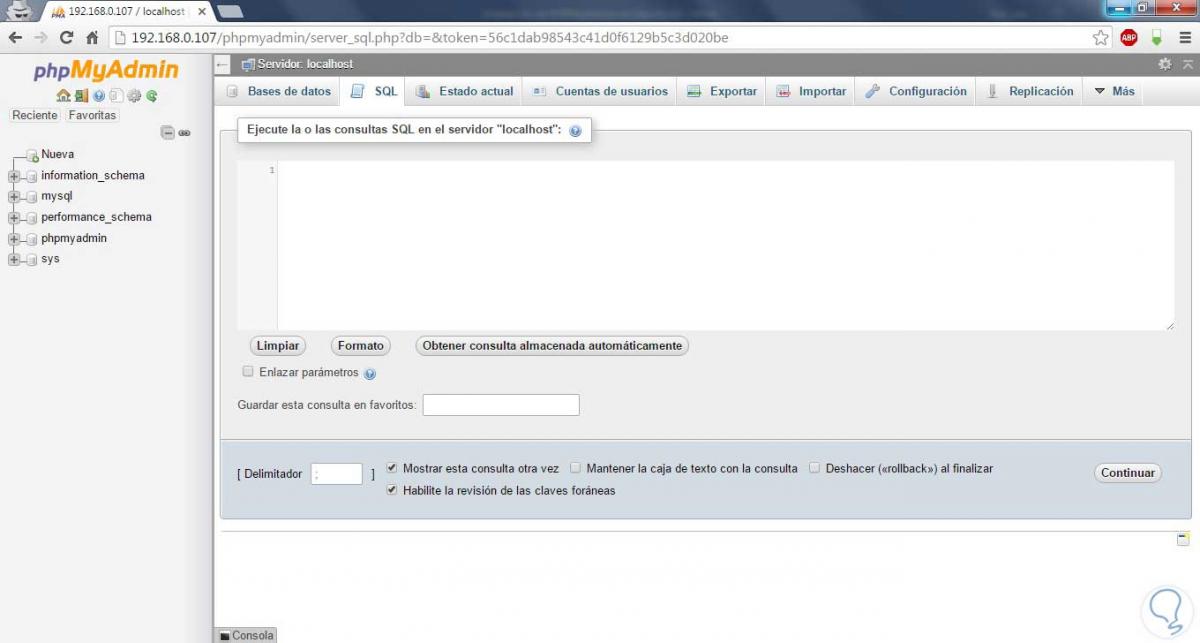

- #INSTALAR PHPMYADMIN UBUNTU PDF#
- #INSTALAR PHPMYADMIN UBUNTU INSTALL#
- #INSTALAR PHPMYADMIN UBUNTU UPDATE#
- #INSTALAR PHPMYADMIN UBUNTU SOFTWARE#
- #INSTALAR PHPMYADMIN UBUNTU PASSWORD#
#INSTALAR PHPMYADMIN UBUNTU PASSWORD#
Enter the username and password you created earlier. The system activates a pop-up that asks for credentials, saying "Restricted files". Go back to your browser window, and open IP_address/phpMyAdmin If you need to add additional users, use the same command without the –c switch, as follows: sudo htpasswd /etc/phpmyadmin/.htpasswd SecondUser Test the Login The system asks to enter and confirm a password. Replace UserNamewith the actual username you want to use to access the phpMyAdmin directory. In the terminal window, enter the following: sudo htpasswd -c /etc/phpmyadmin/.htpasswd UserName The process generates a prompt, forcing anyone trying to access the phpMyAdmin directory to enter a username and password. This step creates a username and password to access the phpMyAdmin directory. Note: For additional configuration options refer to this detailed guide on configuring. htaccess to use basic authentication, to secure restricted files only to valid users, and where to find a list of valid users. In the text editor, add the following lines: AuthType Basic This creates a new file and opens it in a text editor. Enter the following in the terminal: sudo nano /usr/share/phpmyadmin/.htaccess htaccess file allows a more detailed configuration of the Apache web server.

Then, apply the changes by restarting Apache with the following terminal command: sudo systemctl restart apache2 Create. Just below these entries, add the following text: AllowOverride All You should see the following two lines: Options SymLinksIfOwnerMatch In a terminal window, enter the following command to edit the nf file: sudo nano /etc/apache2/conf-available/nf Follow these steps to use Apache's built-in features to restrict access and secure phpMyAdmin directories. Secure phpMyAdmin on Ubuntuīeing easy to use – and free – makes phpMyAdmin a target for hackers. The browser loads the phpMyAdmin dashboard. Enter the username and password you created. Open up a browser window and enter localhost, your server’s IP address or domain name, followed by /phpMyAdmin: localhost/phpMyAdmin 192.168.0.1/phpMyAdmin The browser displays a screen welcoming you to phpMyAdmin, with a login field. Once the operation completes, exit the MySQL shell by entering: exit Step 6: Test phpMyAdmin This changes terminal prompt to show mysql>, indicating that you’re logged into the MySQL shell.Įnter the following commands, replacing UserNamewith a username of your choice, and PassWordwith a strong password of your choice: CREATE USER IDENTIFIED BY 'PassWord' GRANT ALL PRIVILEGES ON *.* TO WITH GRANT OPTION Log in to the MySQL server as follows: sudo mysql However, a simpler method to avoid auth_socket is to create a new administrator account for MySQL. It is possible to change the authentication type. However, this makes using phpMyAdmin difficult. This compares the socket username against the name specified in the MySQL user table and is a tightly-secured authentication method. Restart the Apache service to refresh the changes by entering the following in a terminal: sudo systemctl restart apache2 Step 5: Create a New MySQL Administrator Accountīy default, MySQL 5.7 and later in Ubuntu, authenticate a root user using auth_socket. Press Enter and allow the process to finish.
#INSTALAR PHPMYADMIN UBUNTU PDF#
pdf files to work correctly, but it's not enabled by default.Įnter the following in your terminal to enable mbstring: sudo phpenmod mbstring Select apache2 (use spacebar to choose), press Tab to navigate to and hit Enter. Shortly the installation starts, the installer prompts to choose the web server to automatically configure.
#INSTALAR PHPMYADMIN UBUNTU SOFTWARE#
The system asks for confirmation – press Y then Enter, and the system downloads and installs the phpMyAdmin software package.
#INSTALAR PHPMYADMIN UBUNTU INSTALL#
To install phpMyAdmin, enter the command: sudo apt-get install phpmyadmin
#INSTALAR PHPMYADMIN UBUNTU UPDATE#
Once completed, refresh the software lists by entering the following commands: sudo apt-get update & sudo apt-get upgradeĪllow the operation to finish. If not, the system asks for your password – enter it, then make sure the process completes successfully. If the repository is already enabled, skip to the next step. To add them, open a terminal window and enter the following command: sudo add-apt-repository universe Some Ubuntu 18.04 installations are not configured with the software repositories for phpMyAdmin. Installing phpMyAdmin on Ubuntu Step 1: Add and Update Software Repositories Also, since phpMyAdmin is a popular application, it’s a common vector for attacks. A plain HTTP connection is unencrypted and can be intercepted.

Note: If you’re connecting to a remote server, there’s a security risk in running phpMyAdmin over plain HTTP.


 0 kommentar(er)
0 kommentar(er)
